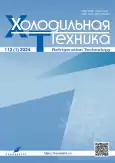Холодильная установка на R744 для небольших супермаркетов
- Авторы: Singh S.1, Pardiñas Á.2, Hafner A.1, Schlemminger C.2, Banasiak K.1
-
Учреждения:
- Norwegian University of Science and Technology
- SINTEF Energy Research
- Выпуск: Том 113, № 1 (2024)
- Страницы: 31-40
- Раздел: Оригинальные исследования
- URL: https://journal-vniispk.ru/0023-124X/article/view/267820
- DOI: https://doi.org/10.17816/RF635873
- ID: 267820
Цитировать
Аннотация
В настоящее время для достижения максимальной производительности системы охлаждения предпочтение отдается прикладным технологическим решениям. Таким образом, сравнительный анализ является важным критерием, который добавляет ценность для оптимального проектирования систем для различных областей применения. В данном исследовании был рассмотрен пример небольшого супермаркета «Молочный бар», для того чтобы оценить потенциал системы охлаждения на основе R744 при аналогичных потребностях в охлаждении и тропических условиях. Данные, собранные в полевых условиях в конкретной временной и температурной зоне, используются для расчета годовой производительности встраиваемых охлаждаемых витрин с ГФУ для применения в областях средних и низких температур. Полученные данные используются для разработки централизованной бустерной системы R744, которая будет покрывать аналогичную нагрузку и потребности в охлаждении всех охлаждаемых витрин в магазине. Исходя из нагрузки на охлаждение для установки с ГФУ, рассчитывается годовая производительность бустерной системы R774 и сравнивается с существующим решением. Годовое потребление электроэнергии для централизованной холодильной системы R744 составляет 3,3 МВт-ч, что на 24% ниже, чем при использовании существующего решения на основе ГФУ. Кроме того, рассматриваются экономические перспективы R744, альтернативные материалы для компонентов и конструкция централизованного блока, которые могут повысить надежность системы и стать эффективной заменой ГФУ технологии для небольших супермаркетов.
Настоящая статья представляет собой перевод статьи Singh S, Pardiñas ÁÁ, Hafner A, Schlemminger C, Banasiak K. R744 Refrigeration Solution for Small Supermarkets. In: Proceedings of the 9th IIR Conference on the Ammonia and CO2 Refrigeration Technologies. Ohrid: IIF/IIR, 2021. DOI: 10.18462/iir.nh3-co2.2021.0030 Публикуется с разрешения правообладателя.
Ключевые слова
Полный текст
Открыть статью на сайте журналаОб авторах
Simarpreet Singh
Norwegian University of Science and Technology
Автор, ответственный за переписку.
Email: simarleo89@gmail.com
Норвегия, Тронхейм
Ángel Pardiñas
SINTEF Energy Research
Email: simarleo89@gmail.com
Норвегия, Тронхейм
Armin Hafner
Norwegian University of Science and Technology
Email: armin.hafner@ntnu.no
Норвегия, Тронхейм
Christian Schlemminger
SINTEF Energy Research
Email: christian.schlemminger@sintef.no
Норвегия, Тронхейм
Krzysztof Banasiak
Norwegian University of Science and Technology
Email: krzysztof.banasiak@ntnu.no
Норвегия, Тронхейм
Список литературы
- Gullo P., Hafner A., Banasiak K. Transcritical R744 refrigeration systems for supermarket applications: Current status and future perspectives // International Journal of Refrigeration. 2018. Vol. 93. P. 269–310. doi: 10.1016/j.ijrefrig.2018.07.001
- Singh S., Hafner A., Maiya M.P., et al. Multiejector CO2 cooling system with evaporative gascooler for a supermarket application in tropical regions // Applied Thermal Engineering. 2021. Vol. 190. doi: 10.1016/j.applthermaleng.2021.116766
- Singh S., Maiya P.M., Hafner A., et al. Energy efficient multiejector CO2 cooling system for high ambient temperature // Thermal Science and Engineering Progress. 2020. 19. doi: 10.1016/j.tsep.2020.100590
- Ali S. The Future of Indian Electricity Demand. Brookings Institution, 2018. Accessed: 09.09.2024. Available from: http://ebooks.cambridge.org/ref/id/CBO9780511996191
- Yari M., Sirousazar M. Cycle improvements to ejector-expansion transcritical CO2 two-stage refrigeration cycle // International Journal of Energy Research. 2007. Vol. 32, N. 7. P. 677–687. doi: 10.1002/er.1385
Дополнительные файлы
















